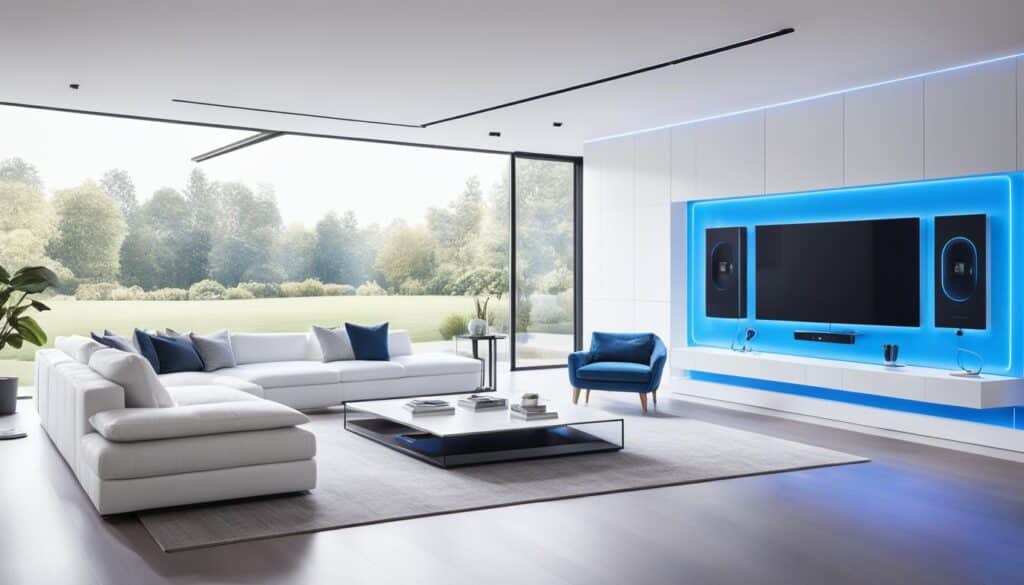Welcome to the exciting world of smart home automation! As technology continues to advance, transforming our homes into smart hubs has become more accessible and convenient than ever before. If you’re a beginner looking to make your home smarter, you’ve come to the right place. In this article, I’ll share some valuable tips to help you get started with smart home automation.
Table of Contents
Key Takeaways:
- Assess your needs and priorities before diving into smart home automation.
- Research and choose reliable devices from reputable brands.
- Set a budget to make informed decisions and avoid overspending.
- Start small and gradually expand your smart home setup over time.
- Educate yourself on the installation and setup process for smart home devices.
By following these tips, you’ll be well on your way to creating a more convenient and connected home environment. Let’s dive in!
Assess Your Needs and Priorities
Before diving into smart home automation, it’s important to assess your needs and priorities. By understanding what areas of your home you’d like to automate and considering your daily routines, you can make informed decisions on which smart devices and systems will best suit your lifestyle.
Start by identifying the aspects of your home that could benefit from automation. For example, think about the lighting in your living spaces, the security measures you’d like to implement, or the entertainment options you want to enhance. By prioritizing these areas, you can focus on finding the right solutions to meet your specific needs.
Here are some questions to help you assess your needs:
- Which areas of your home do you spend most of your time in?
- What tasks or processes do you find repetitive or time-consuming?
- Are there any areas of your home that require enhanced security?
- Do you often host gatherings and want to create an immersive entertainment experience?
By considering these questions, you can narrow down your priorities and determine where smart home automation can bring the most value to your daily life. Whether it’s improving convenience, enhancing security, or creating a more enjoyable living space, assessing your needs and priorities is the first step towards making your home smarter.
Exploring Energy Efficiency and Sustainability in Smart Home Automation
As homeowners increasingly turn to smart home automation, another important aspect to consider is energy efficiency and sustainability. By incorporating smart technology into your home, you can significantly reduce energy consumption and contribute to a more sustainable lifestyle. Here are some ways smart home automation can help achieve these goals:
1. Smart Energy Management:
Many smart home devices come with energy monitoring features that allow homeowners to track their energy usage in real-time. By understanding how much energy each device consumes, you can identify areas where you can reduce usage. Smart plugs, for instance, can provide insights into the energy consumption of individual devices, helping you make informed decisions about usage patterns.
2. Automated Energy Saving:
Smart home automation systems can optimize energy usage by automatically adjusting settings based on occupancy and time of day. For example, smart thermostats can learn your schedule and adjust heating or cooling accordingly, ensuring that energy is not wasted when no one is home. Similarly, smart lighting systems can turn off lights in unoccupied rooms, further reducing energy waste.
3. Integration with Renewable Energy Sources:
If you have solar panels or other renewable energy systems, smart home technology can help you maximize their efficiency. Smart energy systems can monitor your energy production and consumption, allowing you to store excess energy for later use or sell it back to the grid. This not only saves money but also supports the use of sustainable energy sources.
4. Eco-Friendly Device Options:
When selecting smart home devices, look for energy-efficient models that carry certifications such as ENERGY STAR. These devices are designed to minimize energy consumption without compromising functionality. Choosing eco-friendly options contributes to a more sustainable home and often results in lower utility bills.
5. Smart Irrigation Systems:
For homeowners with gardens or lawns, smart irrigation systems can help conserve water. These systems can adjust watering schedules based on weather conditions, soil moisture levels, and plant needs, ensuring that water is used efficiently and only when necessary. This not only saves water but also promotes healthier plants.
Use Case Example: Lighting Automation
“I love having control over the lighting in my home, especially when I come back after a long day at work. With smart home automation, I can set up schedules to automatically turn on the lights in my living room and kitchen when I walk through the door. It creates a warm and welcoming atmosphere and saves me the hassle of fumbling for light switches in the dark.”
– Sarah, Smart Home Enthusiast
Assessing your needs and priorities is the foundation of a successful smart home automation setup. By understanding which areas of your home can benefit the most from automation, you can make informed decisions when choosing smart devices and systems that align with your lifestyle and preferences.
| Benefits of Assessing Needs and Priorities | Considerations |
|---|---|
| Ensures that you invest in the right smart devices and systems | Identify areas of your home that truly benefit from automation |
| Enhances convenience in your daily routines | Prioritize the tasks or processes you want to streamline |
| Optimizes energy usage and reduces costs | Consider the impact of automation on your utility bills |
| Improves home security and peace of mind | Assess which areas of your home require enhanced security measures |
Research and Choose Reliable Devices
Once you have a good idea of your automation needs, it’s important to research and choose reliable devices for your smart home automation setup. With so many options available in the market, selecting the right devices can be overwhelming. However, investing time in careful research will ensure that you make informed decisions and select devices that meet your requirements.
When researching smart devices, consider the following factors:
- Brand reputation: Look for devices from reputable brands that have a proven track record in the industry. Brands with a good reputation typically offer reliable products with advanced features.
- Customer reviews and ratings: Check customer reviews and ratings for the devices you are considering. Pay attention to feedback regarding reliability, performance, and ease of use. Positive reviews from verified customers can help you gauge the overall quality of the device.
- Compatibility: Ensure that the smart devices you choose are compatible with your existing devices and systems. This will enable seamless integration and allow you to control and manage all your devices through a single platform or app.
- Ease of use: Consider the user experience and interface of the smart devices. Look for devices with intuitive control options and user-friendly interfaces, as this will make it easier for you to navigate and operate your smart home.
- Customer support: Check if the brand provides reliable customer support services. This is important in case you encounter any issues or need help with setup or troubleshooting.
By considering these factors, you can confidently choose reliable devices that align with your specific needs and preferences. Building your smart home automation system with trusted devices will ensure a seamless and reliable experience.
Example:
“I spent considerable time researching and comparing different smart devices for my home automation setup. After analyzing customer reviews and checking compatibility, I chose a reputable brand that offered reliable devices with positive feedback. The devices I selected have been working flawlessly and have greatly enhanced the automation capabilities of my home.” – John Doe, Smart Home Enthusiast
| Brand | Customer Reviews | Compatibility | Ease of Use | Customer Support |
|---|---|---|---|---|
| Brand A | 4.5/5 | Yes | Intuitive | 24/7 support |
| Brand B | 4/5 | Yes | User-friendly | Online chat |
| Brand C | 3.8/5 | No | Straightforward | Email support |
Set a Budget
Smart home automation offers a wide range of devices and systems, catering to different needs and budgets. Before you begin shopping for smart devices, it’s important to set a budget to guide your purchasing decisions.
Consider what you’re willing to invest in this technology and prioritize your automation needs accordingly. Determine how much you’re comfortable spending and allocate your budget to different areas of your smart home setup.
By setting a budget, you can make informed decisions and avoid overspending on unnecessary features or devices. It also helps you narrow down your options and focus on products that align with your financial goals.

Remember, setting a budget doesn’t mean compromising on quality or functionality. There are plenty of smart devices available at different price points, so you can find options that suit your needs and budget.
| Price Range | Features | Examples |
|---|---|---|
| $ – $$ | Basic automation features | Smart plugs, basic lighting systems |
| $$ – $$$ | Advanced automation features | Smart thermostats, security cameras |
| $$$+ | High-end automation features | Whole-home automation systems |
Keep in mind that while a higher budget can afford more advanced features and seamless integration, it’s not necessary for a functional and convenient smart home setup. Starting with a manageable budget allows you to gradually expand and upgrade your automation system over time.
Once you’ve set your budget, you can begin exploring the market for smart devices that fit within your price range. Remember to compare prices, read customer reviews, and consider the long-term value and benefits of each device before making a purchase.
Now that you have a budget in place, let’s move on to the next step: starting small and gradually expanding your smart home setup.
Start Small and Expand
As a beginner in smart home automation, it’s best to start small and gradually expand your setup. By choosing a few key devices or systems to implement initially, you can ease yourself into the world of smart homes without feeling overwhelmed. Starting small allows you to become familiar with the technology and its functionalities while giving yourself the opportunity to assess and fine-tune your automation setup before adding more devices.
When starting small, consider focusing on one area of your home that you’d like to automate. Whether it’s your lighting, security, or entertainment systems, select a few devices or smart products related to that area. This approach not only helps you understand the capabilities of these devices but also gives you a chance to experience the benefits of automation firsthand.
Take the time to learn about the features and functionalities of each device you choose. Understand how they integrate with your existing systems and whether they offer compatibility with other smart devices. Compatibility is essential to ensure seamless communication and operation between various devices in your smart home setup.
Once you feel comfortable with your initial setup, you can gradually expand by adding more devices and systems. Research and explore new smart home products that align with your needs and integrate well with your existing setup. Whether it’s smart thermostats, door locks, or voice assistants, expanding your smart home ecosystem can bring even more convenience and control to your daily life.
Starting small and expanding gradually allows you to learn and adapt to smart home automation at your own pace. It gives you the freedom to discover what works best for you and your home, and make informed decisions along the way.

Benefits of Starting Small and Expanding
By starting small and gradually expanding your smart home automation setup, you can experience several benefits:
- Easy Adaptation: Starting with a few devices helps you adjust to the concept of smart home automation without feeling overwhelmed by too many devices and their functionalities.
- Budget-Friendly: Starting small allows you to allocate your budget wisely and invest in devices that align with your needs and preferences.
- Optimal Customization: Building a smart home setup gradually allows you to fine-tune your automation preferences and ensure that each new device integrates smoothly with your existing setup.
- Seamless Integration: Adding new devices gradually ensures compatibility and proper integration with your existing devices, avoiding any conflicts or technical difficulties.
- Enhanced Convenience: As you expand your smart home ecosystem, you’ll unlock new levels of convenience and control over various aspects of your home, making your everyday life easier and more efficient.
Starting small and expanding steadily is a smart approach to building your ideal smart home automation system. It allows you to learn and adapt while enjoying the benefits of a connected and automated living space.
| Benefits of Starting Small and Expanding |
|---|
| Easy Adaptation |
| Budget-Friendly |
| Optimal Customization |
| Seamless Integration |
| Enhanced Convenience |
Educate Yourself on Installation and Setup
Educating yourself on the installation and setup process for smart home devices is crucial. Understanding the setup requirements will help you avoid common pitfalls and ensure that your devices are properly installed and configured for optimal performance. Here are a few tips to get you started:
- Read the user manuals: User manuals provide step-by-step instructions on how to install and set up your smart home devices. Take the time to read and familiarize yourself with the manuals before you begin the installation process.
- Watch installation videos: Many manufacturers provide installation videos that demonstrate the process visually. These videos can be a valuable resource to help you understand the installation steps and ensure you’re doing it correctly.
- Consult professional installers: If you’re unsure or uncomfortable with the installation process, it may be worthwhile to consult a professional installer. They have the expertise and experience to handle complex smart home setups and can ensure that everything is properly installed and configured.
Remember, each smart device may have its own specific installation and setup requirements. Take the time to educate yourself on the process for each device you plan to install, and don’t hesitate to ask for help if needed. By properly installing and setting up your smart home devices, you’ll be able to enjoy their full functionality and make the most of your smart home automation experience.
Table: Comparison of Installation Methods
| Installation Method | Pros | Cons |
|---|---|---|
| Self-installation |
|
|
| Professional installation |
|
|
Secure Your Smart Home Network
With the rise of smart home technology, cybersecurity is a top priority. As you connect various smart devices to your home network, it’s essential to take steps to secure it properly and protect your personal information and privacy.
- Change Default Passwords: One of the first things you should do when setting up your smart home network is to change the default passwords on all your connected devices. Default passwords are easily guessable and make your network vulnerable to hacking. Create strong, unique passwords for each device to increase security.
- Enable Two-Factor Authentication: Where available, enable two-factor authentication (2FA) for your smart home devices. Two-factor authentication adds an extra layer of security by requiring a verification code in addition to a password, making it harder for unauthorized individuals to gain access to your network.
- Keep Firmware Up to Date: Firmware updates provide essential security patches and bug fixes for your smart home devices. Regularly check for firmware updates from the manufacturers of your devices and install them promptly. Outdated firmware can leave your devices vulnerable to security breaches.
- Use Reliable Antivirus Software: Adding an extra layer of protection to your smart home network, consider using a reliable antivirus software on your computers and other devices that connect to the network. Antivirus software helps detect and prevent malware, viruses, and other cyber threats.
- Regularly Check for Firmware Updates: Stay vigilant with firmware updates for your smart home devices. Manufacturers often release updates that address security vulnerabilities and improve overall functionality. Set reminders to check for updates regularly and install them as soon as they become available.
By implementing these security measures, you can significantly enhance the protection of your smart home network and ensure a safe and secure environment for your connected devices and personal data.
| Smart Home Network Security Checklist | |
|---|---|
| Change default passwords on all smart devices | |
| Enable two-factor authentication (2FA) | |
| Keep firmware up to date | |
| Use reliable antivirus software | |
| Regularly check for firmware updates from device manufacturers |
Conclusion
Investing in smart home automation can revolutionize your living experience and transform your home into a smarter, more advanced space. By following these essential tips for beginners, you can ensure a smooth start and gradually build your smart home setup.
First, take the time to assess your needs and priorities. Determine which aspects of your home you want to automate and consider how smart devices can streamline your daily routines.
Next, conduct thorough research and choose reliable devices from reputable brands. Read reviews, check for compatibility, and evaluate ease of use and customer support to make informed decisions.
Setting a budget is crucial. Decide how much you are willing to invest in smart home technology and prioritize your automation needs accordingly. This will prevent overspending and help you make cost-effective choices.
Starting small is advisable for beginners. Begin with a few key devices or systems and gradually expand as you become more comfortable with the technology. This approach allows you to fine-tune your setup and avoid feeling overwhelmed.
Additionally, educating yourself on installation and setup processes is vital. Read user manuals, watch videos, and seek professional guidance when needed. Understanding the requirements will ensure your devices are properly installed and configured for optimal performance.
Lastly, prioritize the security of your smart home network. Change default passwords, enable two-factor authentication if available, and keep firmware and antivirus software up to date. Regularly check for firmware updates from manufacturers to protect against potential vulnerabilities.
By keeping these tips in mind, you can create a more convenient and connected home environment that maximizes the potential of smart home automation. Take the first step today and embark on your journey to a smarter home!
FAQ
What is smart home automation?
Smart home automation is the use of technology to control and automate various devices and systems within your home, such as lighting, security, entertainment, and more, for a more convenient and connected living experience.
How do I assess my needs and priorities for smart home automation?
Start by considering which areas of your home you’d like to automate and think about your daily routines and tasks that could be streamlined with automation. This will help you determine the devices and systems that will best suit your lifestyle.
How can I research and choose reliable smart devices?
Look for devices from reputable brands with positive reviews and ratings. Consider factors such as compatibility, ease of use, and customer support to ensure that you invest in devices that will work seamlessly together and provide a reliable smart home experience.
Should I set a budget for smart home automation?
Yes, it’s important to set a budget before shopping for smart devices. Consider what you’re willing to invest in this technology and prioritize your automation needs accordingly. Setting a budget will help you make informed decisions and avoid overspending.
How do I start small with smart home automation?
As a beginner, choose a few key devices or systems to implement initially and gradually expand over time. This will allow you to become familiar with the technology without overwhelming yourself and give you the opportunity to assess and fine-tune your automation setup before adding more devices.
How can I educate myself on installation and setup for smart home devices?
Read the user manuals, watch installation videos, or consider consulting professional installers if needed. Understanding the setup requirements will help you avoid common pitfalls and ensure that your devices are properly installed and configured for optimal performance.
How do I secure my smart home network?
Before connecting any smart devices to your home network, secure it properly. Change default passwords, enable two-factor authentication if available, and keep your firmware up to date. Additionally, use reliable antivirus software and regularly check for firmware updates from device manufacturers to protect your network from potential vulnerabilities.


